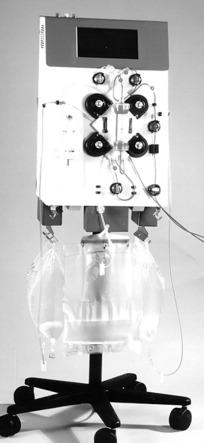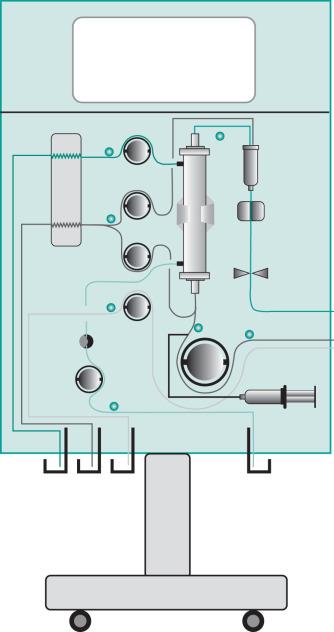Physical Address
304 North Cardinal St.
Dorchester Center, MA 02124
This chapter will:
Provide a brief history of the development and evolution of continuous renal replacement therapy (CRRT) systems.
Describe the basic features of CRRT machines, including the user interface, pumps, pressure monitoring, safety features, and anticoagulation capabilities.
Understand the basic principles of CRRT membranes and filters, especially with regard to the influence of modality, membrane characteristics, and blood/fluid flows on solute transport.
Describe recent developments in CRRT membrane technology.
Between 1965 and 1975, Lee Henderson et al. reported clinical results from therapies using hollow-fiber filters for hemofiltration and ultrafiltration in patients with end-stage renal disease (ESRD). Although these therapies used a blood pump, Kramer et al. subsequently reported an adapted, machine-free method using a similar hollow-fiber device for the treatment of critically ill, fluid-overloaded patients resistant to diuretics. This simple system consisting of arterial and venous catheters connected to a capillary hemofilter by tubing; filtrate pressure was produced by the difference between blood pressure and environmental pressure. This approach was termed continuous arteriovenous hemofiltration (CAVH), although the original description did not mention the use of replacement fluid in the system, whereas a later report did. Along with continuous arteriovenous hemodialysis (CAVHD) and arteriovenous slow continuous ultrafiltration (SCUF), the development of CAVH established continuous renal replacement therapy (CRRT) as a set of treatment modalities for critically ill patients with acute renal failure.
Arteriovenous CRRT modalities had several limitations, especially the unpredictability of blood flow rate and ultrafiltrate production (because of the dependence on the patient's blood pressure) along with the requirement for placement of large-bore catheter in a major artery. As such, interest turned toward developing systems incorporating a blood pump. The first-generation venovenous CRRT machines subsequently developed were simple devices derived from components of standard hemodialysis equipment used for maintenance dialysis. From a safety perspective, monitoring of the extracorporeal circuit typically included standard pressure sensors along with an air/foam detector and blood leak detector on the filtrate/spent dialysate line. In general, these systems either had no or relatively unsophisticated fluid balancing systems, required many procedures (e.g., circuit priming) to be performed manually, and incorporated only rudimentary user interfaces. A major step was the 1994 market introduction of the Prisma system by Gambro (later acquired by Baxter) ( Fig. 141.1 ). This device was developed specifically for continuous treatment in the intensive care unit (ICU), allowing hemodialysis, hemofiltration, and hemodiafiltration (CVVHD, CVVH, and CVVHDF, respectively) with intravenous-quality replacement fluid and/or dialysate. In addition to four pumps for blood, dialysate, replacement fluid, and effluent, this machine had three scales for dialysate, replacement fluid, and effluent. Fluid balancing was achieved by minute-to-minute comparison of actual weights versus expected values based on the prescription, with corrections made to pump speeds based on servo-type software. Another significant achievement with this device was the air-free disposable cassette system having an integrated filter. Finally, the user interface was improved substantially, guiding the user through the various steps required for setting up the machine and rectifying problems. However, the maximum allowable blood flow rate was only 180 mL/min, and total effluent was limited to 5.5 L/hr. The Prisma machine triggered the development of integrated, specialized CRRT machines all over the world. These newer machines included three to five pumps and three to four scales able to handle 12 to 20 L of replacement fluid or dialysate and capable of producing blood flows up to 400 to 600 mL/min. The general trend has been toward more fully automated machines that allow all renal support treatment modes at higher blood flow and fluid exchange rates. In addition, these recent devices have been developed with more emphasis on human factors, especially at the user interface, in an attempt to improve safety and the quality of delivered therapy. Another feature of many of the new machines is the ability to perform adjunctive therapies, including liver and respiratory support. Finally, specific functionalities, such as those enabling regional citrate anticoagulation, have been included in some newer devices.

The remainder of this chapter provides more specific technical details regarding the latest generation of CRRT machines. Much of this information ultimately can be traced to the Charta of Vicenza, which led to the organization of a recent consensus conference termed the Nomenclature Standardization Initiative (NSI). For this initiative, members of the clinical community and industry collaborated to develop standardized terminology for dialysis therapies used in the management of critically ill patients with acute kidney injury (AKI) and other disorders.
A diagram demonstrating the major features of the typical contemporary CRRT machine appears in Fig. 141.2 . The following provides commentary on the different aspects of these devices; several commercially available devices are shown in Fig. 141.3 . Although different CRRT modalities are mentioned in this chapter, a more detailed discussion of them occurs in other sections of this book.


Although early generations of CRRT machines provided relatively limited treatment information to the user, the interface between the user and contemporary devices is now much more sophisticated. In addition to basic treatment information, such as actual flow rates, elapsed time, and circuit pressures, modern machines also provide instantaneous and cumulative values for critical parameters, especially those related to fluid balance on an ongoing basis. In addition, discrepancies between prescribed and delivered (actual) values for treatment time and effluent volume allow assessments of treatment adequacy. Current machines also provide a number of timely alerts, including those related to a potentially adverse circuit pressure trend (suggesting impending circuit clotting) and the need for a bag change. From a safety perspective, an important addition in the past decade has been the incorporation of device software that controls the deviation from prescribed fluid removal rates. Newer features also remind the user to assess the cause of an alarm signifying such as a deviation and the magnitude of the fluid imbalance that may arise. Finally, many machines now have the operator's manual and tutorials directly available to the user at the screen. Of course, a prerequisite for the user to achieve the maximum benefit from these new safety features is adequate training, primarily at the institutional level but also from the manufacturer when necessary.
Become a Clinical Tree membership for Full access and enjoy Unlimited articles
If you are a member. Log in here